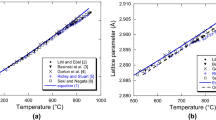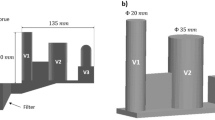Abstract
Amongst the possible defects that can appear during casting, voids due to solidification shrinkage is certainly the most usual and important in the case of cast irons. For any predicting work, the knowledge of the density of the phases of interest, namely liquid, austenite and graphite, is a prerequisite. The density of liquid and austenite in silicon cast irons are here assessed as function of composition and temperature based on the literature review. Estimate of theoretical expansion upon solidification are then derived for lamellar and spheroidal graphite cast irons and compared to reported experimental values obtained in near-equilibrium conditions.










Similar content being viewed by others
References
A. Jablonka, K. Harste, K. Schwerdtfeger, Steel Research 62, 24–33 (1991)
J. Miettinen, Metall. Mater. Trans. B 28, 281–297 (1997)
L.D. Lucas, Mém. Sci. Rev. Métall. 61, 97–116 (1964)
E.J. Ash, C.M. Saeger, Bureau of Standards J. Res. 8, 601–614 (1932)
T. Yoshikawa, Mater. Trans. 54, 1968–1974 (2013)
I. Jimbo, A.W. Cramb, Metall. Trans. B 24, 5–10 (1993)
A. Olsson, Scand. J. Metall. 10, 263–271 (1981)
C. Dumay, A.W. Cramb, Metall. Mater. Trans. B 26, 173–176 (1995)
Y.M. Gertman, P.V. Gel′d, Russian J. Phys. Chem. 36, 788–792 (1962)
N.K. Dzhemilev, S.L. Popel, B.V. Tsarewskiy, Fiz. Metal. Metalloved 18, 83–87 (1964)
Y. Kawai, K. Mori, M. Kishimoto, Tetsu-to-Hagane 60, 29–37 (1974)
J. Lacaze, O. Dezellus, Metall. Mater. Trans. B 53, 161–177 (2022)
Calculations perfomed with the THERMOCALC software and the TCFE-8 database, https://www.thermocalc.com/
T. Kusakawa, S.Y. Kim, T. Kondo, Report of the Castings Research Laboratory. Waseda Univ. 23, 23–32 (1972)
K. Hellström, L. Diaconu, A. Dioszegi, China Foundry 17, 127–136 (2020)
L.D. Lucas, Mém. Sci. Rev. Métall. 69, 479–492 (1972)
Z.S. Basinski, W. Hume-Rothery, A.L. Sutton, Proc. Roy. Soc. A 229, 459–467 (1955)
N. Ridley, H. Stuart, Metal Sci. J. 4, 219–222 (1970)
G.H. Cockett, C.D. Davis, J. Iron Steel Inst., 1963, 110–115
E.W.L. Qiming Chen, O.N. Hansen, Scand. J. Metallurgy 23, 3–8 (1994)
P. Dietrich, G. Lesoult, Simulation of heat transfer and capillary feeding during solidification of sand mold S.G. iron castings, In: State of the art of computer simulation of casting and solidification processes, E-MRS Proceedings, vol. 34, pp. 225–235 (1986)
R.W. Heine, AFS Trans. 96, 413–422 (1988)
M. Hecht, La Santé des Pièces en Fontes à Graphite Sphéroïdal, (ETIF, Sèvres, France, 2008)
C.E. Bates, G.L. Oliver, R.H. McSwain, AFS Trans. 85, 289–298 (1977)
A. Kagawa, S. Kiguchi, M. Osada, Trans. Jpn. Foundrymen’s Soc. 18, 18–23 (1995)
D.M. Stefanescu, M. Moran, S. Boonmee, W.L. Guesser, AFS Trans. 120, 355–364 (2012)
J.M. Théret, G. Lesoult, Hommes et Fonderie, February issue, 19–30 (1984)
S.E. Wetterfall, H. Fredriksson, M. Hillert, J. Iron Steel Inst. 210, 323–333 (1972)
M. Rappaz, J.M. Drezet, M. Gremaud, Metall. Mater. Trans. A 30, 449–455 (1999)
G. Lesoult, Int. J. Cast Metals Res. 22, 2–7 (2009)
E.S. Kweon, D.H. Roh, S.B. Kim, et al., Inter Metalcast 14, 601–609 (2020). https://doi.org/10.1007/s40962-020-00417-2
G. Lesoult, M. Castro, J. Lacaze, Acta Mater. 46, 983–995 (1998)
J. Lacaze, G. Lesoult, M. Castro, Acta Mater. 46, 997–1010 (1998)
K.M. Pedersen, J.H. Hattel, N. Tiedje, Acta Mater. 54, 5103–5114 (2006)
M.K. Bjerre, M.A. Azeem, N.S. Tiedje, J. Thorborg, P.D. Lee, J.H. Hattel, Model. Simul. Mater. Sci. Eng. 26, 085012 (2018)
G. Rivera, P.R. Calvillo, R. Boeri, Y. Houbaert, J. Sikora, Inter. J. Metalcast. 14(4), 1172 (2020)
U. Tewari et al., Metall. Mater. Trans. B 52B, 633 (2021)
N. Lekakh, X. Zhang, W. Tucker, H.K. Lee, T. Selly, J.D. Schiffbauer, Mater. Charact. 158, 109991 (2019)
Acknowledgements
Vasile-Lucian Diaconu, Björn Domeij and Attila Dioszegi from JTU University (Sweden) are warmly acknowledged for helping in getting relevant references. We are indebted to the reviewers for their pressure to add some final comments concerning the limits of the idealized model.
Author information
Authors and Affiliations
Corresponding author
Ethics declarations
Conflict of interest
The authors declare that they have no conflict of interest.
Additional information
Publisher's Note
Springer Nature remains neutral with regard to jurisdictional claims in published maps and institutional affiliations.
Appendices
Appendix A
Values Selected for Comparing Fe–Si data from Various Works
See Table
2.
Appendix B
Composition of the Fe-30 at% Si alloy Saturated in Carbon5
In a study dedicated to surface tension of Fe–Si and Fe–Si–C alloys, Yoshikawa used Fe–Si alloys that were then carbon saturated at various temperatures to give Fe–Si–C alloys. In the present work, data for a Fe–Si alloy with 30 at% Si were considered. Carbon saturation of this alloy was carried out in graphite crucibles leading to a change in composition of the melt that was calculated using the TCFE-8 database. The results of these calculations are given in mass percent in Table
3 where are also listed the experimental and calculated values of the density.
Appendix C
Data from Ash and Saeger4
Ash and Saeger measured the specific volume of a series of liquid cast irons and plotted them in their Figure 1. These results have been picked up from their figure and are replotted in Figure
11. Some of the melts were duplicates and the corresponding results were given without being differentiated (e.g., alloys III and IV in Figure 11). Table
4 lists the compositions of the alloys studied by Ash and Saeger, selecting, however, only one of the compositions in case of duplicates. In the original figure by Ash and Saeger, lines were drawn through the data that were nearly but not exactly parallel, while the choice was made to plot parallel lines in Figure 11.
As it can be noticed in Table 4, the alloys contained different amounts of phosphorus, suggesting checking the effect of this element as assessed in the main text. The comparison of the densities calculated with Eqn. (13) without the P terms and the experimental ones in Figure
Calculated versus experimental density values when P is not accounted for in Eqn. (13). The dashed line is the bisector.
12 shows an agreement that could appear satisfactory, with a difference of less than 1.5%. However, accounting for P gave an agreement at better than 0.7% as seen in Fig.
Calculated versus experimental density values when P is accounted for in Eqn. (13). The dashed line is the bisector.
13.
Rights and permissions
Springer Nature or its licensor holds exclusive rights to this article under a publishing agreement with the author(s) or other rightsholder(s); author self-archiving of the accepted manuscript version of this article is solely governed by the terms of such publishing agreement and applicable law.
About this article
Cite this article
Lacaze, J., Sertucha, J. & de la Torre, U. Density change upon solidification of silicon cast irons. Inter Metalcast 17, 1493–1506 (2023). https://doi.org/10.1007/s40962-022-00868-9
Received:
Accepted:
Published:
Issue Date:
DOI: https://doi.org/10.1007/s40962-022-00868-9







